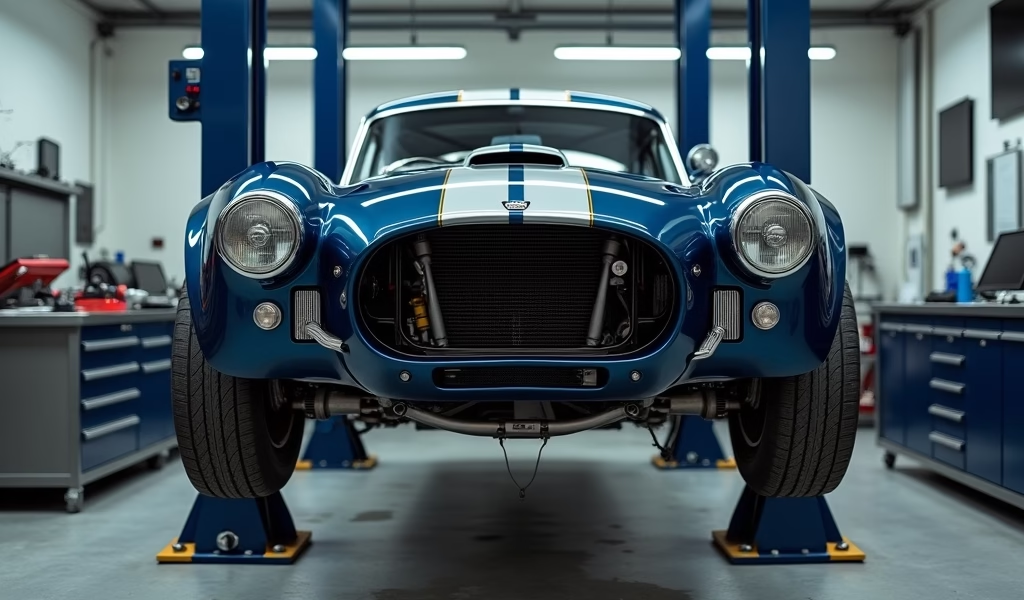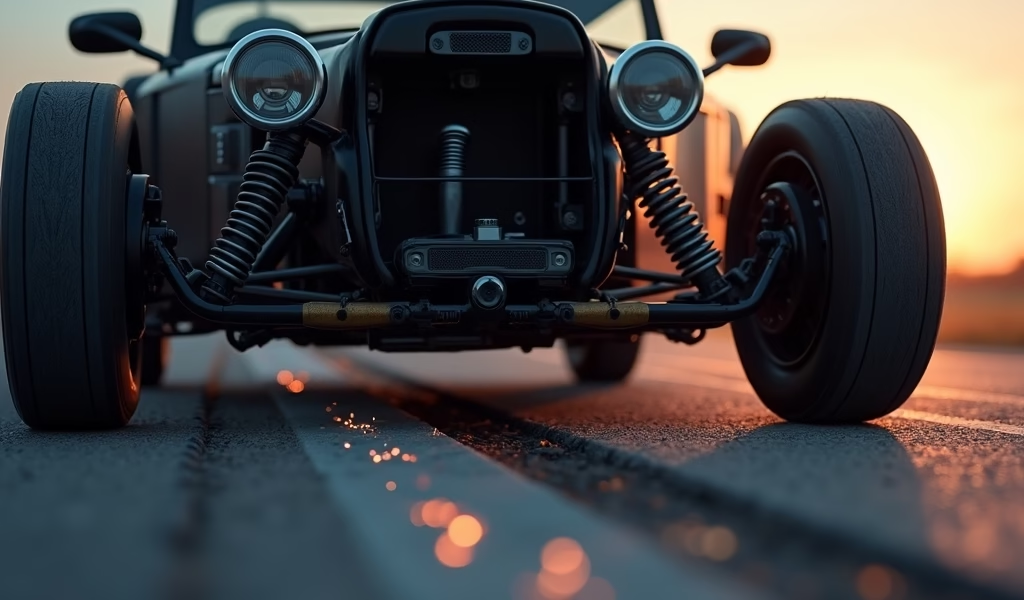Overview
Ackermann steering geometry ensures the inside wheel turns at a sharper angle than the outside wheel during cornering, with problems manifesting as uneven tire wear, pulling during turns, and handling issues. The article details five key solutions: adjusting tie rod lengths, realigning steering arms, modifying steering geometry, replacing worn components, and seeking professional alignment services—emphasizing the importance of proper geometry for both safety and performance.
Table of Contents
- What is Ackermann Steering Geometry?
- Signs of Ackermann Steering Problems
- Top 5 Fixes for Ackermann Steering Issues
- Fix 1: Adjusting Tie Rod Lengths
- Fix 2: Realigning the Steering Arms
- Fix 3: Modifying the Steering Geometry
- Fix 4: Replacing Worn Components
- Fix 5: Professional Alignment Service
- DIY vs Professional Repair
- Conclusion
- Frequently Asked Questions
What is Ackermann Steering Geometry?
Ackermann steering geometry is one of those automotive concepts that sounds complex but actually solves a pretty straightforward problem. When you’re turning your vehicle, the inside wheel needs to follow a tighter arc than the outside wheel. If they turned at the same angle, you’d get tire scrubbing, excessive wear, and poor handling.
The Ackermann principle addresses this by designing the steering linkage so the inside wheel turns at a sharper angle than the outside wheel. This geometry was developed back in the 1800s by Rudolph Ackermann, a German carriage builder. Though vehicles have changed dramatically since then, this fundamental steering principle remains essential in modern automotive design.
In a properly designed Ackermann system, the steering arms are angled so that imaginary lines drawn through them would meet at the center of the rear axle. This creates what engineers call “toe-out on turns” – exactly what you want for smooth cornering. When everything’s working correctly, you’ll enjoy precise steering response, reduced tire wear, and better stability at all speeds.
Signs of Ackermann Steering Problems
When your Ackermann steering geometry goes haywire, your vehicle will definitely let you know. You might not recognize it as an Ackermann issue specifically, but the symptoms are hard to miss.
The most obvious sign is uneven tire wear, particularly on the inside or outside edges. If you’re seeing this pattern, your wheels aren’t tracking properly during turns. Another telltale indicator is a stubborn pull to one side during cornering – your vehicle should track predictably through turns, not fight you every step of the way.
Notice your steering wheel doesn’t return to center smoothly after completing a turn? That’s another red flag. Your kingpin inclination angle works together with Ackermann geometry, and when either is off, self-centering action suffers.
Some drivers also report increased steering effort or a “binding” sensation during tight turns. This happens when the wheels aren’t following their proper turning radius, creating resistance. According to research from the Society of Automotive Engineers, improper Ackermann can increase steering effort by up to 15% in some vehicles.
Perhaps the most concerning symptom is unpredictable handling at higher speeds. When your steering geometry is compromised, stability suffers – especially during emergency maneuvers. If your vehicle feels “darty” or uncertain at highway speeds, don’t ignore it.

Top 5 Fixes for Ackermann Steering Issues
When your car’s Ackermann steering geometry is giving you trouble, there are several effective solutions. I’ve spent years in the shop tackling these issues, and these five fixes consistently deliver results. Let’s dive into what actually works for restoring proper steering performance.
Each solution addresses different aspects of the steering system, from simple adjustments to more comprehensive overhauls. The right fix for your vehicle will depend on the specific symptoms, the severity of the problem, and whether you’re dealing with stock components or aftermarket modifications.
Remember that steering is a safety-critical system. While some of these repairs are DIY-friendly, others require specialized equipment and expertise. Don’t hesitate to consult a professional if you’re uncertain about tackling the job yourself.
Fix 1: Adjusting Tie Rod Lengths
The simplest and most common fix for Ackermann steering issues involves adjusting your tie rod lengths. These critical components connect your steering rack to the steering knuckles, directly affecting how your wheels turn in relation to each other.
To tackle this adjustment, you’ll need to:
- Loosen the lock nuts on both tie rod ends
- Rotate the inner tie rod to adjust length (clockwise shortens, counterclockwise lengthens)
- Make equal adjustments to both sides initially
- Re-tighten lock nuts to factory torque specifications
- Check toe settings with alignment equipment
The goal here is to achieve the manufacturer’s specified toe settings while maintaining equal tie rod lengths side-to-side. Uneven tie rod lengths can dramatically throw off your Ackermann geometry, creating handling problems that worsen as steering angle increases.
This adjustment directly affects your vehicle’s wheel alignment toe adjustment, which is crucial for straight-line stability. Even a few millimeters of difference can noticeably impact handling. Take your time with this adjustment, and verify your results with proper alignment equipment if possible.
The beauty of tie rod adjustments is their simplicity and effectiveness. In many cases, correcting tie rod lengths resolves Ackermann issues without requiring more extensive repairs. Just be sure to double-check your toe settings afterward – improper toe can accelerate tire wear even if your Ackermann geometry is correct.
Fix 2: Realigning the Steering Arms
When tie rod adjustments aren’t enough, the next step is addressing the steering arms themselves. These components establish the fundamental Ackermann angle in your steering system, and they sometimes need realignment or replacement.
In older vehicles with serviceable steering components, you may be able to adjust the steering arm angle by:
- Loosening the mounting bolts on the steering arms
- Adjusting the arm position slightly (usually only a few degrees are needed)
- Re-tightening to factory specifications
- Verifying the adjustment with a turning radius test
Modern vehicles typically have steering arms integrated into the knuckle assembly, making adjustment impossible without specialized equipment. In these cases, replacement with the correct parts is your only option. Aftermarket steering arms are available for many popular vehicles, some offering improved Ackermann geometry over stock parts.
The tie rod end alignment procedure becomes particularly critical when working with steering arms. The connection points between your tie rods and steering arms must be precisely positioned to maintain proper geometry throughout the steering range.
This repair requires more technical knowledge than simple tie rod adjustments, but it addresses the root cause of many Ackermann issues. When done correctly, realigning the steering arms provides more consistent turning behavior and improved tire wear patterns.
Fix 3: Modifying the Steering Geometry

For those willing to take on more extensive modifications, changing the actual steering geometry offers tremendous benefits. This approach is particularly relevant for performance applications or when addressing design limitations in certain vehicles.
Modifying steering geometry typically involves:
- Installing aftermarket steering arms with different Ackermann angles
- Relocating tie rod mounting points
- Sometimes modifying the steering rack or box positioning
- Comprehensive alignment following modifications
Performance vehicles often benefit from reduced Ackermann effect (sometimes called “anti-Ackermann”), which provides more consistent grip in high-speed corners. According to Race Car Engineering, many modern race cars use significantly less Ackermann angle than street vehicles.
The key to successful geometry modification is understanding what you’re trying to accomplish. Different driving conditions benefit from different geometry settings. Autocross and track vehicles benefit from settings that would be inappropriate for daily driving on varying road surfaces.
This approach requires specialized knowledge and often custom fabrication. If you’re considering this route, consulting with a motorsports alignment specialist first is wise. They can help you determine the optimal geometry for your specific application and suggest the most effective way to achieve it.
Fix 4: Replacing Worn Components
Sometimes the issue isn’t with the design of your Ackermann geometry but with worn components that prevent the system from working as intended. Suspension and steering wear is inevitable over time, and addressing these worn parts can restore proper function.
Key components to inspect and potentially replace include:
- Ball joints (upper and lower)
- Control arm bushings
- Tie rod ends (inner and outer)
- Steering rack mounts
- Wheel bearings
Worn components introduce unwanted movement and flexibility into the system, making precise steering geometry impossible to maintain. Even perfect Ackermann design is undermined when components aren’t holding their intended positions.
Pay particular attention to any rubber bushings in the system – these deteriorate over time and are often overlooked. Even minor bushing deflection can significantly impact steering precision, especially during dynamic maneuvers.
The advantage of this approach is that you’re restoring the system to its original design specifications rather than trying to improve upon them. For most daily-driven vehicles, this is the most practical and cost-effective solution to Ackermann steering issues.
Fix 5: Professional Alignment Service
When all else fails – or if you want to ensure everything’s done right the first time – a professional alignment service is worth every penny. Modern alignment equipment can measure aspects of your steering geometry that are impossible to assess with the naked eye.
A comprehensive professional alignment will:
- Measure current toe, camber, and caster settings
- Compare measurements to manufacturer specifications
- Make necessary adjustments to restore proper geometry
- Provide before-and-after documentation
- Identify any components that need replacement
The real value of professional service is in the expertise and equipment. Modern computerized alignment systems can detect issues with turning radius and Ackermann geometry that traditional alignment methods might miss. This technology has revolutionized steering diagnosis, according to the Hunter Engineering Company, a leading manufacturer of alignment systems.
Even if you’re comfortable with DIY repairs, consider having a professional alignment check as your final step. It provides validation that your repairs were successful and establishes a baseline for future reference. Many shops offer free alignment checks, making this an easy way to confirm your steering geometry is correct.
DIY vs Professional Repair
When facing Ackermann steering issues, you have to decide whether to tackle the problem yourself or leave it to the professionals. There’s no one-size-fits-all answer here – it depends on your mechanical aptitude, available tools, and the complexity of your specific issue.
DIY repairs make sense when:
- You have experience with suspension and steering work
- The issue involves simple tie rod adjustments
- You have access to basic alignment equipment
- You’re working on an older vehicle with more accessible components
Professional repairs are preferable when:
- The problem requires specialized diagnostic equipment
- You’re dealing with a modern vehicle with complex electronic steering
- The issue involves structural components or steering arm replacement
- You need documentation of the repairs (for warranty or insurance purposes)
Remember that even if you perform the physical repairs yourself, a professional alignment check afterward is always a good idea. This hybrid approach gives you the satisfaction and cost savings of DIY work with the confidence of professional verification.
Whichever route you choose, don’t underestimate the importance of proper Ackermann geometry. It affects everything from tire wear to emergency handling – making it well worth addressing correctly the first time.
Conclusion
Ackermann steering geometry might seem like an obscure technical concept, but its impact on your vehicle’s handling and safety is substantial. From the uneven tire wear that hits your wallet to the handling quirks that affect your confidence behind the wheel, proper steering geometry matters in everyday driving.
The five fixes we’ve explored – adjusting tie rods, realigning steering arms, modifying geometry, replacing worn components, and seeking professional alignment – provide a comprehensive toolkit for addressing Ackermann issues. Start with the simplest solutions and work your way up as needed.
Remember that steering is fundamentally a safety system. While DIY repairs are certainly possible, don’t hesitate to consult professionals when you’re unsure. Your vehicle’s handling characteristics affect not just comfort and tire wear, but also your ability to respond in emergency situations.
With proper attention to your Ackermann steering geometry, you can enjoy precise handling, extended tire life, and the confidence that comes from knowing your vehicle will respond predictably in all driving scenarios. It’s an investment in both safety and driving pleasure that pays dividends every time you take the wheel.
Frequently Asked Questions
What exactly does Ackermann steering geometry do?
Ackermann steering geometry ensures the inside wheel turns at a sharper angle than the outside wheel during cornering. This prevents tire scrubbing and improves handling by allowing each wheel to follow its appropriate turning radius.
How often should Ackermann steering geometry be checked?
Have it checked during regular wheel alignments (typically every 15,000-30,000 miles) or whenever you notice uneven tire wear or handling issues. Any suspension modifications or significant impacts also warrant a geometry check.
Can I adjust Ackermann geometry myself?
Basic adjustments like tie rod length can be DIY-friendly with the right tools and knowledge. However, more complex modifications to steering arms or geometry typically require professional equipment and expertise.
Does Ackermann geometry affect fuel economy?
Yes, incorrect Ackermann geometry increases rolling resistance through tire scrub, potentially reducing fuel economy by 1-3%. Proper geometry allows tires to roll more freely, improving efficiency.
Are aftermarket steering components better for Ackermann geometry?
Not necessarily—quality aftermarket components can offer improved geometry for specific applications, but many are designed for performance rather than everyday driving. OEM components generally provide the best balance for daily use.

